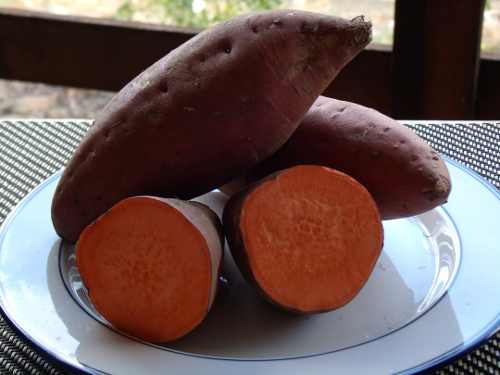
These orange-fleshed garnet yams may be candied or mashed for Thanksgiving, but are not related to true yams, which are native to Africa. Rather, they're a colorful version of traditional sweet potatoes, with a moister texture. Photo by Esther Oertel.
A bit of a discrepancy exists surrounding the difference between sweet potatoes and yams. Many of us will serve sweet potatoes as an accompaniment to our Thanksgiving meals, perhaps candied or mashed, but will refer to them as yams.
And who can blame us? Orange-fleshed sweet potatoes are sold in stores as yams. Even promotional Web sites, such as the one which markets Louisiana sweet potatoes, contribute to the confusion with recipes such as yam bisque and a mascot named “Yamster the Hamster.”
The truth is that what we know as yams in North America is almost always a version of sweet potato. True yams, native to Africa and Asia, are another genus of plant, completely unrelated to sweet potatoes, which have their origins in South America.
So why does this overlap in names exist?
Several decades ago when orange fleshed sweet potatoes were introduced in the southern United States, producers and shippers dubbed them yams to distinguish them from the traditional lighter fleshed ones. Although the terms are generally used interchangeably, the U.S. Department of Agriculture requires that the label "yam" always be accompanied by "sweet potato.”
True yams may be found in Latin or Caribbean grocery stores, and I’ll write about them separately in another column.
Not only are the sweet potato’s large, tuberous roots edible, but the young shoots and leaves are sometimes used as greens. Sweet potato blossoms reveal the plant’s membership in the morning glory family, as they bear a striking resemblance to that climbing garden flower.
The smooth skin of the long, tapered roots can be purple, red, brown, or beige, with flesh that ranges from beige through yellow, orange and purple.
They’re beloved around the world, where they hold a place in the cuisines of Africa and Asia, as well as in the Americas.
They’re a favorite street food in places such as Egypt and Japan, where vendors typically bake them.
Dried slices of sweet potato roots are a staple food in Uganda, and in West African counties, such as Guinea, Sierra Leone, and Liberia, the young leaves and vine tips are widely consumed as a vegetable.
In Asia, a variety of cuisines utilize the sweet potato, including in China, Japan, the Philippines, Korea, India, Malaysia, Taiwan, Vietnam and Singapore.
Sweet potatoes are important in the typhoon-prone countries of the Pacific, as they’re not as affected by flooding as other staple crops.
Sweet potato soup flavored with ginger is made in China, Koreans use sweet potato starch to make cellophane noodles, and the Japanese use it in tempura and to make pastries, particularly the purple variety, which was developed there.
Multinational pizza chains in Korea use sweet potatoes as a topping.
There’s an interesting twist to the sweet potato story. While the center of origin and domestication of the sweet potato is thought to be in Central or South America, it was also grown in Polynesia before western exploration there.
Current thought holds that the sea-faring Polynesians brought the sweet potato back from travels to South America. From there it likely spread to Hawaii and New Zealand, where the Maori people also cultivated sweet potatoes before European contact.
I just experimented with making a sweet potato soup that turned out to be surprisingly delicious in its simplest form. I boiled three peeled, cubed orange-fleshed sweet potatoes (marketed as garnet yams) in a quart of vegetable broth until tender and pureed the mixture in batches in a blender.
It was perfect just as it was, rich and flavorful, even with no added seasonings. With a little less cooking broth, it would have made a nice side dish of pureed sweet potatoes.
When I attempted to develop it further by adding coconut milk, it took some time to balance the flavors with curry powder, peanut oil and lemon juice. I was happy with the end result; even so, it didn’t quite measure up to the soup in its purest evolution.
Sweet potatoes are versatile in that they may be cooked by many processes, including baking, steaming, boiling, deep-frying or pan frying, microwaving, and cooking in hot ash or coals.
To cook them in the ash or coals of a barbecue or fire pit, prick them several times and wrap in aluminum foil (use a double wrapping if they’ll be among coals) and place them among the coals or immersed in hot ash. (Use a double wrapping of foil if among coals). Check them for tenderness after about 20 minutes.
If desired, they may be rubbed with spices prior to cooking. Chef Jamie Oliver suggests a mixture of crushed chili peppers, cumin, and salt, and served with a squeeze of lime after they’re done.
Sweet potatoes are full of beta-carotene, which converts to vitamin A in our systems. They also contain good amounts of dietary fiber, vitamin B6 and vitamin C.
Sweet potatoes are beautiful when baked into a pie, and having one on your Thanksgiving dessert table may be a nice change from (or an addition to) the pumpkin pie that’s typically served. Maple syrup or bourbon are flavorful additions to sweet potato pies.
Today’s recipe is a unique one, a sweet potato “butter” that may be used as a dip or spread. It’s wonderful with corn bread or a nutty whole wheat loaf.
Sweet potato butter
2 garlic cloves
2 sweet potatoes, peeled and diced
2 medium carrots, peeled and diced
1/2 to 3/4 cup vegetable broth
1 tablespoon extra-virgin olive oil
Sea salt and freshly-ground black pepper to taste
2 tablespoons chopped fresh parsley (optional)
2 tablespoons chopped fresh cilantro (optional)
Put unpeeled garlic cloves on aluminum foil and bake at 350 degrees F. for about 10 minutes, until soft.
Boil potatoes and carrots until tender; drain.
Put vegetables in a food processor and squeeze in the baked garlic. Add 1/2 cup broth and blend. With motor running, add oil and keep blending, adding more broth until puree is fairly smooth and full.
Add salt and pepper to taste. Stir in optional chopped fresh herbs if using dip immediately. Otherwise, see below.
Dip can be made as long as a day in advance, covered and refrigerated. Bring to room temperature for serving and stir in the optional herbs right before serving with raw vegetables and bread sticks.
Makes six servings.
Esther Oertel, the “Veggie Girl,” is a culinary coach and educator and is passionate about local produce. Oertel gives private cooking lessons. She welcomes your questions and comments; e-mail her at This email address is being protected from spambots. You need JavaScript enabled to view it..
Follow Lake County News on Twitter at http://twitter.com/LakeCoNews, on Tumblr at www.lakeconews.tumblr.com, on Facebook at http://www.facebook.com/pages/Lake-County-News/143156775604?ref=mf and on YouTube at http://www.youtube.com/user/LakeCoNews.














